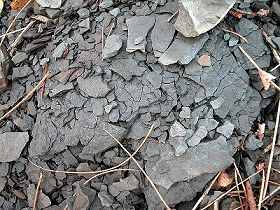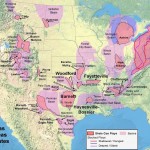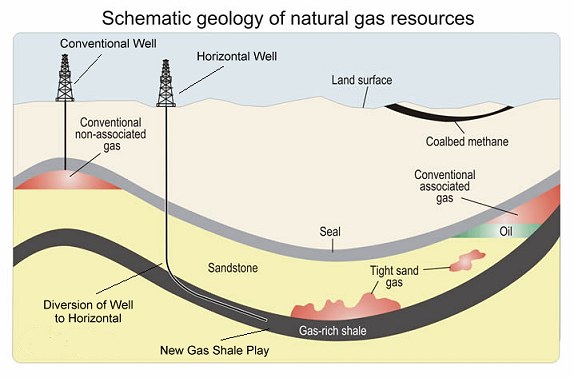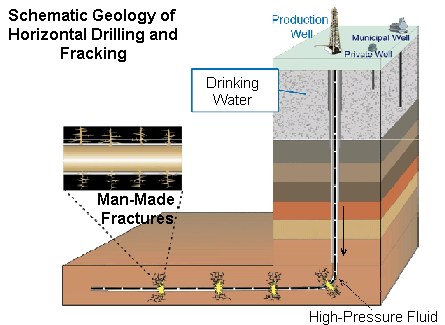Shale Gas, Oil, and Hydraulic Fracturing (Fracking)
A New Chance to be Energy Independent!
Shale gas is an exciting new resource which has only become available in the the last few years. Shale gas and fracking technologies have helped the United States become energy-independent for the first time in many years.
In the 1900’s, our country became more and more dependent on foreign sources of energy — especially crude oil. We can’t do anything to control the price (despite what politicians say), and we put our whole  nation at risk to ensure our supply. We have paid a much bigger price than simply the money it costs to heat our homes and run our automobiles. The hidden costs are the lives of our soldiers and our allies that are traded to far-flung corners of the earth to ensure the stream of hydrocarbons keeps flowing. We need an energy policy that works toward the creation of new jobs, and results in a clean, long-lasting supply of affordable energy.
nation at risk to ensure our supply. We have paid a much bigger price than simply the money it costs to heat our homes and run our automobiles. The hidden costs are the lives of our soldiers and our allies that are traded to far-flung corners of the earth to ensure the stream of hydrocarbons keeps flowing. We need an energy policy that works toward the creation of new jobs, and results in a clean, long-lasting supply of affordable energy.
Over the past 30 years, a story has quietly been unfolding in America. It started in Texas, but it later spread out to cover most areas of the country. It’s the discovery of making shale gas economic to produce. It sounds a little boring. Well, that depends on whether you would prefer to ride or walk. Or, more seriously, whether you would rather send yourself or your children off to to foreign lands to fight wars for energy resources, rather than develop what you already have right in your own back yard!
New Potential!
Here’s a common, ordinary rock often seen at the surface of the earth. It’s the most common  sedimentary rock of all. It’s called shale.
sedimentary rock of all. It’s called shale.
Since we started drilling on a large-scale basis for oil and gas well over a century ago, we have drilled through a heck of a lot of shale in our search for conventional oil and gas reservoirs. We had to drill mostly through shale in order to reach the “good” reservoir rocks containing oil and gas, namely sandstones and porous limestones. Shales were known to contain gas — even oil — it was just very difficult to make economic completions in shale formations, due to their low natural permeability.
Though gas has been produced from shales for a very long time (mainly in the Appalachian Basin), the wells were often weak, and barely economic. A well might make only 200-300 million cubic feet of gas over a 50-year lifespan. That’s not much gas for an expensive hole.
But much has changed since the early 1980’s. Shale gas wells are being drilled now that may make several billion cubic feet (or more) of gas over their lifetime!
During the 1980’s, a company called Mitchell Energy embarked on a quest to make shale gas pay. Just north of Fort Worth, Texas, the company started a program to test the Barnett Shale, and make it economic. Years of careful drilling and research into horizontal drilling and new hydraulic fracturing techniques finally paid off. The breakthrough finally came in the 1990’s when the company switched to a new frac fluid that was almost 100% water. Prior to this, it was widely accepted that too much water was bad for fracking shale formations. By 2002, there were over 1500 well completions in the Barnett Shale. This success started a new wave of natural gas shale-drilling, with many new basins being explored for shale gas.
Some of these shales produce oil. Oil has been produced in great quantities from the Bakken formation of North Dakota/Montana since 2000, when the new fracking techniques started to be employed. Though the Bakken formation had produced small quantities of oil for fifty years before that, new technologies soon shoved North Dakota to 2nd place in US oil production, right behind Texas. While oil production is important, the tremendous gas shale reserves in the US can be expected to last much longer. IF the policies of the United States allow them to be produced.
New Producing Areas!
 This map shows the location of some of the major shale-producing areas in the United States. Click the map for a much larger view (large file, 1 MB)
This map shows the location of some of the major shale-producing areas in the United States. Click the map for a much larger view (large file, 1 MB)
New Horizontal Drilling Technologies!
Look at the picture below. Gas and oil-rich shales are the new target rock for many companies. We have been drilling on a large scale for the “conventional” types of oil and gas targets for well over a  century. Note the two “conventional” traps in the diagram; the one on the left side shows non-associated gas (few oil liquids are present in the formation; this may also be called dry gas). the one on the right shows gas associated with oil liquids. But the well penetrating the deeper “gas-rich shale” is a new type of technology. Why is it different?
century. Note the two “conventional” traps in the diagram; the one on the left side shows non-associated gas (few oil liquids are present in the formation; this may also be called dry gas). the one on the right shows gas associated with oil liquids. But the well penetrating the deeper “gas-rich shale” is a new type of technology. Why is it different?
1) When the drill bit reaches the shale, the hole is turned so that the bit bores horizontally, or near-horizontally, through the shale deposit. This turning process and bit-control is called geosteering.
2) Tremendous advances in the last 20 years in the field of hydraulic fracturing (fracking) enable gas to be produced from formerly near-impermeable shale reservoirs. A typical “frac job” in such a reservoir might consist of 1-2 million gallons of water and 50-100 thousand pounds of extremely well-sorted sand. This large “frack” may extensively break down the area around a borehole that is up to 5,000 feet long (Fracking is not new, but the news organizations would have you believe it is!).
3) Natural shale gas is an abundant, clean-burning natural resource that we control, right here in our own country. It’s a truly widespread resource that is providing new jobs to a new generation, and finally breaking our dependence on foreign oil!
New “Fracking” Techniques!
In the fracturing (fracking or fracing) process, several layers of steel casing are set to approximately 1000′ depth to protect sources of drinking water. After all the casing is cemented, and perforations are  made in the casing into the much deeper shale formation, fluids (almost 100% water) are pumped down the hole under tremendous pressure. This fluid exits the wellbore at the perforation locations, and the tremendous pressure fractures the shale gas formation, allowing gas to flow into the well.
made in the casing into the much deeper shale formation, fluids (almost 100% water) are pumped down the hole under tremendous pressure. This fluid exits the wellbore at the perforation locations, and the tremendous pressure fractures the shale gas formation, allowing gas to flow into the well.
Thousands of feet of sediments separate the gas formations from the drinking-water formations. The greater this distance, the less likely the fracturing process can interfere with the ground water.
The new advances in shale-gas technology mean that we now have the potential to become energy-independent, for the first time in many years. Natural gas can be applied to any energy-needy situation, from heating our homes to powering our automobiles. With a new push toward shale-gas technology, we can free ourselves from imported oil to create a safer, cleaner, energy alternative.
